17.01.2005
Mark DVORETSKY. EXCHANGE OF QUEENS. Part 2.
ACTIVE QUEEN OF THE OPPONENT
The particular case of the more general principle: it makes sense to exchange active opponent's pieces.
Makarychev – Naumkin
Championship of Moscow 1983

1.?
It seems that it's better to attack. But a tempting 29.Јb1? is wrong because of 29...0-0! 30.Ґb4 Јf3, and White is on a razor's edge (31.Јc2 d4! 32.Ґ:e7 d3 33.Јd1 Јe4+ 34.ўd2 ¦b8, etc.).
29.Јd1-c1!
White impedes a castling by exchanging the queens and, in spite of the lack of two pawns, gets a great advantage. And with the queens on the board a castling is possible, even if it's connected with the lost of a knight: the open position of the white king provides Black with real counter-chances. It means that 29...Јa4! (or 29...Јb3) 30.f3! 0-0! should have been played.
31.¦:e7 Јd4І.
29...Ј:c1+? 30.Ґ:c1 (the danger of 31.Ґa3) 30...ўd8 31.¦:a7 ¦e8 32.Ґa3 f6 33.f4 fe 34.fe ¤c6 35.¦:g7 ¤:e5 36.Ґd6 ¤c6 37.g5 hg 38.h6 ¤d4 39.h7 ¤f5 40.Ґc7+ ўc8 41.¦g8.Black resigned.
Cuper – Petrosian
Olympiad, Buenos Aires1978
1.d4 ¤f6 2.c4 e6 3.¤c3 Ґb4 4.Ґg5 c5 5.d5 d6 (5...Ґ:c3+ 6.bcd6) 6.e3 (6.¦c1!?) 6...Ґ:c3+ 7.bce5 8.Ґd3 ¤bd7 9.f4!?
To 9.f3 comes 9...¤f8, planning ¤g6 and h7-h6. Tigran Petrosian recommends 9.¤e2!? with the idea 9...¤f8 10.¤g3 h6 11.Ґ:f6 Ј:f6 12.¤h5 Јg5 13.h4 Ј:g2 14.¤g3ќ. Black defends himself by 9...h6 10.Ґh4 e4! 11.Ґc2 Јe7.
9...h6 10.Ґh4 ¦g8 11.¤h3! (11.¤f3? e4! 12.Ґ:e4 g5) 11...Јa5 12.Јd2 (suggested by Petrosian 12.ўd2?! is dubious because of 12...b5!, and 13.cb? c4! loses) 12...e4 13.Ґe2 Јa4 (there is a danger of 14...¤b6) 14.¤f2 g5 15.fg hg 16.Ґg3 ¤b6
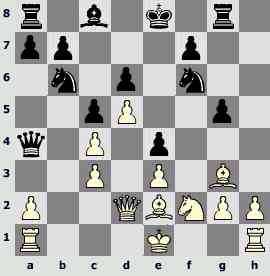
1.?
17.Ґ:d6? ¤:c4 18.Ґ:c4 Ј:c4µ is not advantageous. White exchanged queens to secure the pawn с4.
17.Јd1?! Ј:d1+ 18.¦:d1 ўe7 19.h4 Ґf5! 20.0-0 ¤bd7! 21.¦b1! b6 22.h5 ¦g7 23.Ґh2g4! (preventing 24.g4І) 24.¤h1 Ґh7.In the arisen difficult ending the chances of the players are approximately equal.
The exchanging operation should have been at least postponed.
17.0-0!
That move lays a subtle snare before the opponent – a capture of a pawn is unobviously disproved.
17...¤:c4? 18.Јd1!! ¤b6 (in case of 18...Ј:d1 19.¤:d1 both black knights are endangered) 19.Јb1! (not only threatening by a mortal check on b5, but also aiming at the pawn e4) 19...Ґd7 (19...ўd8 20.Ґ:d6 are alsohopeless) 20.Ґd1! (20.Ґ:d6 ¤b:d5 is far less convincing) 20...Јc4 (20...Јa5 21.¤:e4) 21.Ґb3 Јe2 22.¦e1 with subsequent 23.¤:e4, and the defence is destroyed.
The position of Black is distinctly worse also in case of 17...ўe7?! 18.¤d1! ¦g6 19.¤b2 Јa3 (19...Јe8!?) 20.¦f2 Ґd7 21.¦af1. The only reliable way is 17...¦g6! – having protected the knight, Black proceeds with threatening to capture a pawn and maintains an approximate balance. It's clear that from the practical standpoint it made sense for White to take such a chance (but to start with, it should be found).
I showed this example at the training gathering before the Junior world championships in 2004. Children proposed one more interesting way to solve the problem of the weak pawn с4: 17.¤d1!?. If 17...¤:c4, then 18.¤b2! ¤:b2 19.Ј:b2±. The position of Black isn't better after 17...Ґg4 18.0-0 Ґ:e2 19.¤b2! and 20.¦:f6, and 17...ўe7 18.0-0 brings the position to the above examined variant (17.0-0 ўe7?! 18.¤d1). Finally aconsolidatingmaneuver 17...Јd7! 18.0-0 Јe7 was found (with subsequent ¤b6-d7-e5) – it's not easy for White to attack there, mainly because of the unsuccessful position of his knight.
Timman – Portisch
2nd game of the Challengers' match, Antwerp 1989

1.?
40.Јe2:b5!
After the exchange of queens White has a decisive advantage in the ending because of a possibility of pawn break-through at the king side and because of the weakness of the pawns g7 and h6. For example: 40...cb 41.ўc2 ўb7 42.ўd3 ўc6 43.ўd4, planning f4-f5, Ґe7, f6. Not less strong are 43.ўe4 ¤c5+ 44.ўd4, or even 44.Ґ:c5 ў:c5 45.a3! with subsequent f3-f4-f5. (And a hasty 45.f4? seems to miss a win because of 45...b4! 46.f5 ef+ 47.gfa5 48.e6 ўd6!.)
Alas, in the game Timman played differently.
40.Јe3? ўb7. If Black has queens, he has sufficient counter-chances because of the open position of the white king.
41.Јf4 Јd3+ 42.ўb2 Јe2+ 43.ўa3 Јa6+ 44.ўb2 Јe2+ 45.ўa3 Јa6+.Adraw.
Nikolich – Timman
Amsterdam 1984
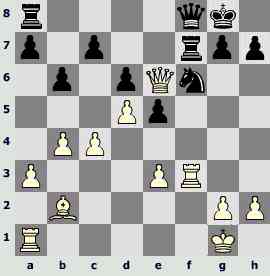
1...?
In the earlier examined game Karpov – Timman the bishop of White was bad, because it abutted against his pawns. Here there is a less common, but also quite important case: the bishop is bad, as he is firmly confined by the opponent's pawns.
21. . . . Јf8-c8!
The only active piece of White is the queen. Having forced its exchange, Black gets a very favourable ending. 21...Јe8?! 22.Јh3, or 21...¦e8?! 22.Јf5! are less convincing (22.Јh3 ¤e4 23.¦:f7 Ј:f7 24.¦f1 Јg6 are worse), and after 21...g6?! 22.Јh3 ¤e4 23.¦:f7 Ј:f7 24.¦f1 everything is all right for White.
22.Ј:c8+ ¦:c8 23.¦c1 c5!?. A good, but not the only possible plan. It was possible to try also 23...c6!?, without fear of 24.c5 cd 25.cd ¦:c1+ 26.Ґ:c1 ¤d7!µ. The position that arises in case of 24.dc!? is analyzed in the next comment.
Jan Timman declined 23...¤e4 because of 24.¦:f7 ў:f7 25.c5!? (a passive defence is cheerless: 25.ўf1 ўe7 26.ўe2 ¦f8 27.¦c2 h5µ) 25...bc 26.bc ¤:c5 27.Ґ:e5 with equalization. However, havingplayed 26...¦b8! (instead of 26...¤:c5?) 27.cd cd, he would get an obvious advantage as in addition to the problems with inactive and vulnerable bishop b2 he got the weakness of the pawn d5.
24.b5?. It's a serious positional mistake. Now the bishop will never enter the play, and the position of White becomes strategically hopeless. 24.bc? bc isn't better (Black will immediately occupy the line "b"). It was necessary to clear the lines for the bishop, which could be done by 24.dc! ¦:c6 25.c5! (but certainly not mentioned by Timman 25.b5? ¦c8 26.a4 ¦fc7 27.Ґa3 ¤e4°) 25...bc 26.bc. However even in this situation Black kept chances to win, proceeding either with 26...¦d7!? 27.cd ¦:c1+ 28.Ґ:c1 ¦:d6 29.h3 (if 29.Ґb2, then 29...¤g4!µ) 29...ўf7, or 26...¦fc7!? 27.¦d1! ¦:c5 28.¦:d6 ¦b7.
24...a6 25.ba ¦a7 26.¦f2 ¦:a6 27.¦b1 ¤e4 28.¦c2 ¦f8 29.Ґc1. To 29.¦f1 Timman gives the variant 29...¦b8! 30.¦b1 b5 31.Ґc1 b4!°.
29...h5! 30.Ґb2 ¦a4 (impeding 31.¦f1 in view of 31...¦:f1+ 32.ў:f1 ¦:c4!) 31.h4
In case of 31.Ґc1, as Timman noted, Black could organize an intrusion through the king side by means of 31...¦a7! 32.¦:b6 ¦af7 33.g3 (33.h4 ¦f1+ 34.ўh2 ¦e1 35.g3 ¦ff1 36.Ґb2 ¤f6° isn't better) 33...¦f1+ 34.ўg2 ¦1f2+ 35.¦:f2 ¦:f2+ 36.ўg1 ¦c2°.
31...¦f6 32.ўh2 (32.Ґc1!?) 32...¦f2 33.¦bc1 ¦d2! 34.ўh3 ¦d3 35.¦e1 (35.¦e2 ¦d2!) 35...¤d2.White resigned.
TRANSITION INTO A FAVOURABLE ENDING
Tukmakov – Gulko
Championship of the USSR, Leningrad 1977
1.d4 ¤f6 2.c4 e6 3.¤f3 b6 4.g3 Ґa6 5.Јa4 c6 6.¤c3 b5!? 7.cbcb 8.¤:b5 Јb6 9.¤c3 Ґb4 10.Ґg2 0-0 11.Јc2. In this opening variant Black gets a good positional compensation for the sacrificed pawn. White often returns it immediately, striving for a quick development: 11.0-0 Ґ:c3 12.bc Ґ:e2 13.¦e1, but after 13...Ґb5 14.Јb3 d5 the position becomes equal (Vukic – Bronstein, Saraevo 1971). 11.Ґd2 ¤c6 is also not convincing.
In the game Sakaev – Berzinsh, Duisburg 1992 White got an advantage by 11.Јd1!? ¦c8 12.Ґd2 d5 13.0-0 Ґ:c3 14.Ґ:c3 ¤e4 15.¦c1 ¤d7 16.¦e1! ¦ab8 17.Јa4 Ґb5 18.Јa3. Probablyit should be met by 11...¤e4!? 12.Ґd2 Ґ:c3.
11...¤c6 12.0-0 ¦fc8 13.a3 Ґ:c3 14.bc ¤d5 15.¦d1 ¤ce7 16.Ґb2 ¦ab8 17.¦ab1

1...?
17. . . . Јb6-b3!
The white queen defends vulnerable pawns с3 and е2, it should be exchanged. 17...Јa5?! 18.e4 areweaker, andno 18...¤:c3? 19.Ґ:c3ќ.
18.Јc2:b3 ¦b8:b3
19.¤f3-d2 ¦b3-b6!
Black wins back a pawn, holding the initiative.
20.Ґf3 ¤:c3 21.Ґ:c3 ¦:c3 22.¦bc1?!. If 22.¦:b6 ab 23.¦b1, thensimply 23...¤c8 24.¦b3 ¦c2µ. Defending such positions, it's important to look for an appropriate moment for activating your forces, even if you have to immolate something for that. In this case I can recommend 22.¤e4! ¦:a3 23.¦a1 ¦:a1 24.¦:a1, planning 25.¤c5, that will come even in response to 24...d6.
The plan, chosen by Vladimir Tukmakov, is far weaker.
22...¦:a3 23.¦c7 Ґb5 24.¦dc1 ўf8 25.¤c4 Ґ:c4 26.¦7:c4 ўe8 27.¦1c2 ўd8 28.ўg2 a5. Black probably has an already won position.
29.¦c5 ¦b8 30.d5!? ed! 31.Ґ:d5 ¤:d5. Boris Gulko considered the variant 31...d6 32.¦c7 ¤:d5 33.¦:f7 ¤c3 34.¦:g7 h5 to be insufficiently convincing.
32.¦:d5 ¦a8! 33.¦c4. Maybe, it was worthy to look for chances to rescue after 33.¦cc5 a4 34.¦a5 ¦:a5 35.¦:a5 ўc7, though that rook ending is cheerless as well.
33...a4 34.¦h5 h6 35.¦g4 ¦a6 36.¦:g7 ¦b3 37.¦h7 a3 38.¦5:h6 ¦a7 (38...f6!) 39.¦:f7 ¦bb7! (certainly not 39...a2? 40.¦h8+ ўc7 41.¦:d7+!) 40.¦h8+ ўc7 41.¦f3, and White resigned in view of 41...a2 42.¦c3+ ўd6 43.¦h6+ ўe7 44.¦e3+ ўf7 45.¦f3+ ўg7 46.¦ff6 d6!.
Tartakover – Pirts
Interzonal tournament, Saltshobaden 1948

1...?
21. . . . Јd8-e7!
The exchange suggested by White should be rejected. The next move of Black will be 22...c5. With queens he has worse, but a defendable position.
In the game Vasya Pirts transited to the lost ending: 21...Ј:d1+? 22.ў:d1.
To put up a defence Black needs two pawn moves: с7-с5 and f6-f5. But according to the rules only one of them is possible, and White will have time to impede the other one. To 22...c5 there come 23.bc bc 24.Ґg4!, and if 24...a5 (with the idea Ґa6), then 25.Ґd7!, reserving for himself the resource Ґb5 and preparing ўc2-b3-a4. 22...Ґc6 23.Ґc8 a5 24.Ґa6 aren't better, for example, 24...ўf8 25.Ґb5 Ґe8 26.f5, and in the pawn ending the king will inevitably come on f4. Finally, to 22...ўf8 the respond 23.Ґf5!? h6 24.g4 is possible.
22...f5 23.c5! b5 24.ўd2 ўg7 25.ўc3 ўf6 26.ўd4 ўe6 27.Ґd1 Ґd5 28.g4 c6 29.g5 Ґc4 30.a4 Ґd5 31.h4 Ґc4 32.h5 Ґd5 33.h6 Ґa2 34.ўc3 Ґd5 35.a5 ўd7 36.Ґh5 ўe7 37.g6 fg 38.Ґ:g6 ўf6 39.Ґ:h7 Ґe6 40.ўd4 (zugzwang) 40...Ґd7 41.Ґg8. Black resigned.
Adorjan – Lukac
Championship of Hungary 1970
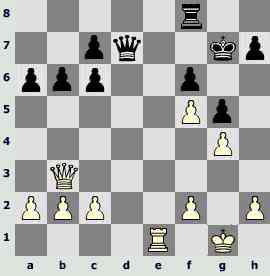
1.?
Neither 24.¦e6 Јd1+ 25.ўg2 Ј:g4+, nor 24.Јe6 Јd4 are effective (with double blow on g4 and b2), and if 24.h3, then 24...¦e8 with equalization. It's certainly possible to prevent the exchange of rooks by the move 24.Јe3, but it is unclear what is to be done after 24...c5 or 24...¦f7.
24.Јb3-d3!!
In the rook ending White has a position for win owing to his space advantage (and as a result a confined position of the black king), and, what's the most important, owing to the inactivity of the opponent's rook, which will be absorbed in defence of its pawns.
Black has an alternative 24...Ј:d3 or 24...Јd5. I'd prefer the first possibility.
After 25.cd ¦f7! (25...¦d8 26.¦e7+ are bad, and in case of 25...c5 26.¦e7+!? ¦f7 27.¦:f7+ ў:f7 28.f4! a pawn ending will be already hopeless) 26.¦e6 (26.b4? ¦d7 27.¦c1 ¦:d3 28.¦:c6 ¦d4 29.¦:c7+ ўg8= are insufficient) 26...c5 27.ўf1 ¦d7 27.ўe2, though the black rook will be absorbed in defence of the pawn c7, it is however situated on the open line, that gives some hopes to a counter-play in the future.
Probably, Peter Lukac thought the transition into the pawn ending to be unsafe: 24...Ј:d3 25.¦e7+!? ¦f7 26.¦:f7+ ў:f7 27.cd. The advantage of White is doubtless here, but it's not so evident, whether it's sufficient for a win. Black plays 27...ўe7, and with 28.h4 or 28.d4 he fails to find a win. White will have to calculate precisely the variant 28.f4! gf 29.ўf2 ўd6 30.ўf3 ўe5 31.d4+! ў:d4 32.g5! (32.ў:f4? ўd5, and 33.g5? fg+ 34.ў:g5 ўe5 are even losing, and 33.h4 ўd6 34.g5 ўe7 lead to a draw) 32...ўe5 33.g6 hg 34.fg ўe6 35.ў:f4 c5 36.h4, and the white pawn is the first to reach the promotion square.
24...Јd5?! 25.Ј:d5!. Andras Adorjan probably even didn't consider 25.Ј:a6?!.
25...cd 26.¦e6 ¦f7 27.ўf1 h5 28.h3 hg 29.hg. The position of Black is hopeless in connection with sharp distinction in position of rooks. Activity of a rook is the principal estimating criterion in the rook endings.
29...a5 30.a4! ¦d7 31.ўe2 ўf7 32.ўd3 ¦d8 33.¦c6 ¦d7 34.ўd4 ўg7 35.f3 ўf7 36.c3! ўe7 37.b4 ab 38.cb ўf7 39.a5 ba 40.ba ¦e7 41.a6. Blackresigned.
Simagin – Benko
Match Moscow – Budapest 1949
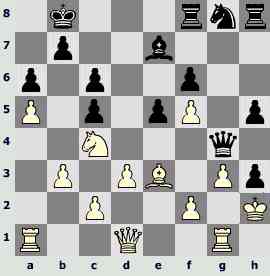
1.?
20.Јd1:g4! h5:g4
21.f2-f3!±
"Destroying the pawn chain of Black at the king side, White opens up the game and starts using his positional advantage" (Vladimir Simagin).
21...gf 22.¦af1 Ґd8?!(22...¤h6 23.Ґ:h6 ¦:h6 24.¦:f3 Ґd8 are better) 23.¦:f3Ґc7 24.Ґ:c5 ¦f7 25.Ґb6! ¤h6 26.g4 ¦fh7 (26...¦g7 27.g5) 27.g5 fg 28.¦:g5 ¤f7 29.¦g6 ўc8 30.Ґ:c7 ў:c7 31.¦fg3, and White won.
Huebner – Petrosian
7th game of the Candidate's match, Seville 1971
1.e4 c5 2.¤f3 d6 3.¤c3 e6 4.d4 cd 5.¤:d4 ¤f6 6.Ґe3 Ґe7 7.f4 ¤c6 8.Јf3 e5 9.¤:c6 bc 10.fe (10.f5!?) 10...de (10...¤g4!?) 11.Ґc4 0-0 12.h3. To 12.0-0 come 12...¤g4 13.¦ad1 ¤:e3! 14.¦:d8 Ґ:d8 or 14.Ґ:f7+ ўh8 15.Ј:e3 Јb6.
12...Ґe6 13.Ґ:e6 fe 14.Јe2 ¦b8. It'd be interesting to try proposed by Mikhail Tal 14...¤d5!? 15.ed Ґh4+ 16.ўd1 cd, but such playing isn't in the style of Petrosian.
15.0-0! (15.¦b1 ¦b4) 15...¦:b2 16.¦ab1 ¦b4! 17.Јa6 Јc7 18.a3 ¦:b1 19.¦:b1 ¦a8 20.a4 h6
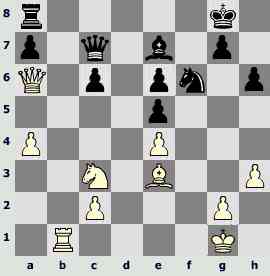
1.?
White should have exchanged the queens.
21.Јa6-b7! Јc7:b7
22.¦b1:b7 Ґe7-d8
23.¦b7:a7
Certainly not 23.Ґ:a7? ¦:a7!.
23. . . . ¦a8:a7
24.Ґe3:a7 Ґd8-a5
25.¤c3-d1! ¤f6:e4
26.¤d1-e3
The knight is striving to c4. In spite of an extra pawn, Black has a worse position, as a distant passed pawn "а" is quite dangerous. All the other possibilities are weaker:
21.¦b7? Јc8, and white pieces are pinned;
21.Јc4 a5!? 22.Ј:e6+ ўh8 (there is a danger of 23...Ґb4) 23.Ґb6 Јd7 24.Ј:e5 Ґb4 with the idea ¦e8.
In the game it was played 21.a5? ўh7! 22.Јb7 Ј:a5!. Distinctive weapon of Petrosian is a sacrifice of exchange. However there was no choice: 22...Ј:b7? 23.¦:b7 Ґd8 24.a6 Ґa5 25.¤a4 ¤:e4 26.¦:a7 are absolutely bad.
23.Ј:a8 Ј:c3 24.Ј:a7 ¤:e4©.In the subsequent complicated and far from being faultless struggle White made the last mistake.
25.¦f1?. 25.Ј:e7 Ј:e3+ 26.ўh1! maintained the balance (but not 26.ўh2? Јg3+ 27.ўg1 ¤d2!). And the move in the game could be rebutted by 25...¤g3! 26.¦f7 Јe1+ 27.ўh2 ¤f5 28.Ґf2 Јd2 with very unpleasant threat 29...ўg6.
25...Ґh4? 26.¦f7 Ґf6 27.ўh2 Ј:c2 28.Јd7 Јb3 29.Ґf2. Tal recommended 29.¦f8! Ґh4! (29...Ј:e3 30.Јe8=) 30.Јf7! Ґg3+ 31.ўh1 ¤f6 32.Јa7! Јb1+ 33.Ґg1 with a fair chance of a draw.
29...Јd5 30.Јa7 Јd2. Simple30...¤:f2!? 31.Ј:f2 ўg6! with subsequent 32...e4 (but, certainly, not immediately 31...e4?? 32.Ј:f6) are very strong.
31.Јe3 Јc2 32.Ґe1 c5 (32...¤d6!?) 33.h4 c4 34.¦c7 Јd3 (34...¤d6!? 35.Јc5 Јd1) 35.Јf3?. As Igor Zaitsev noted, 35.Јh3! Јd5 36.Јg4 led to a draw.
35...Јb1! 36.Јe3?!. Black also kept advantage in case of 36.¦:c4!? ¤d6 37.¦c6 (37.¦c7? Ј:e1 38.Ј:f6 ¤e8°) 37...Ј:e1 38.¦:d6 Ј:h4+, but the consequences of the move in the game are still worse.
36...¤d6 37.Јd2

1...?
Time trouble conclusion of the duel turned out to be an absurd one: 37...¤f5? 38.¦:c4 e4 39.Јc2?? Ј:e1 40.¦:e4 Ґe5+.Whiteresigned.
After the game other ways of retreat of the queen at the 39th move were recommended, but they also seem to be losing ones: 39.Јe2? Ґe5+ 40.ўg1 ¤d4 (40...¤g3 is equivalent) 41.Јd2 Ґf4! or 39.Јb4? Ґe5+ 40.ўg1 Јd3! 41.¦:e4 Ґd4+ 42.¦:d4 ¤:d4 with difficult ending. An unexpected move 39.¦b4! was salutary, for example: 39...Јd3 (39...Ґe5+ 40.ўh3) 40.Ј:d3 ed 41.¦b3.
It is customary to assume that in the position at the diagram Black was winning, having chosen 37...e4?, – but in fact after 38.Ј:d6 Ј:e1 39.Јf4 the position became equal.
A simple move 37...Јb6! is very strong, but, perhaps, the most convincing way to gain a decisive advantage was connected with the exchange of queens: 37...Јd3! 38.¦d7 Ј:d2 39.Ґ:d2 e4 or 39...¤b5.
Seirawan – Kozul
Wijk-an-Zee 1991
1.d4 ¤f6 2.c4 g6 3.¤c3 Ґg7 4.e4 d6 5.Ґd3 0-0 6.¤ge2. This rare system is a speciality of GM Seirawan, who won a lot of excellent games using it. Here is one of them.
6...¤c6 7.0-0 e5 8.d5 ¤d4 9.f3!?(in the "Encyclopaedia of chess openings" the main channel is 9.¤:d4 ed 10.¤e2) 9...c5 10.¤:d4! cd 11.¤a4! Ґd7 (9...¤d7?! 10.b4 f5 11.c5) 12.b4 a5 13.b5! b6?. It's a hardly noticeable, but a considerable inaccuracy, that permits White to get advantage. Seirawan recommends 13...Јc7 14.Ґg5 (14.b6 Ґ:a4) 14...h6.
14.f4!(the danger of 15.fe de 16.c5!) 14...¤g4 15.f5 gf! 16.ef Јh4 17.h3 ¤e3 18.Ґ:e3 de
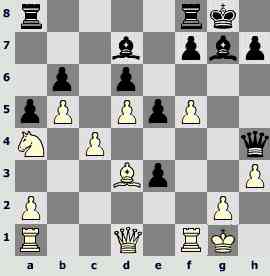
1.?
19.Јd1-g4!!
A Brilliant move! By sacrifice of exchange, White liquidates the counter-play of the opponent and gets a decisive positional advantage. Other continuations, according to analysis of American master John Watson and Sherlock... sorry, Yasser Seirawan, led to unclear consequences:
19.¤:b6?! Јd4 20.ўh1 Ј:b6 (20...e4 21.¤:d7 ed 22.f6 e2 23.Јd2 efЈ+ 24.¦:f1ќ are not correct) 21.f6 (the danger of 22.Ґ:h7+) 21...Јd4! 22.fg ў:g7 – Black wants to play f7-f5 and e5-e4;
19.f6?! Ґ:f6 20.¤:b6 e4 (certainly not 20...Јd4? 21.Ґ:h7+) 21.¦:f6 [21.¤:d7? Ґ:a1 22.Ј:a1 ed 23.¤f6+ ўh8 24.¤h5+ f6 25.¤:f6 e2 26.¤h5+ ¦f6] 21...Ј:f6 22.¤:d7 Јf2+ 23.ўh1 ed 24.Јg4+ ўh8 25.Јd4+ f6 26.¤:f8 ¦:f8 27.Ј:d3 e2.
19. . . . Јh4:g4
20.h3:g4 e5-e4
21.Ґd3-e2!
Both 21.Ґ:e4? e2 22.¦fe1 Ґ:a1 23.¦:a1 ¦fe8° and 21.f6? ed 22.fg (22.¤:b6 Ґh6!) 22...¦fb8 are not correct.
21. . . . Ґg7:a1
22.¦f1:a1
In spite of the material advantage, Black has a bad position. One of his rooks will have to defend the weak pawn b6, and for the other one there is no open line, along which it's possible to display activity. Meanwhile White plans to move the king on f4 and to play ¦h1-h6.
22...¦ab8 23.ўh2 h5!? 24.gh Ґ:f5 25.ўg3?!. It's inaccuracy, which however doesn't change the estimation of the position. As Seirawan noted 25.¦f1! Ґh7 26.¦f6! ¦fd8 27.g4! ўf8 28.ўg3 ўe7 29.¦h6 ¦h8 30.g5ќ were stronger.
25...ўg7 26.ўf4 Ґh7 27.g4! f6 28.¤c3 ўh6 29.¤d1 ¦be8 30.¤:e3 ¦e5 31.¦f1. It's possible also to play 31.¦d1!? with subsequent ¦d4, Ґd1-c2 or even c4-c5.
31...¦g8 32.Ґd1 (planning Ґb3, c4-c5) 32...f5? 33.Ґe2! ¦g5 34.c5! bc 35.b6 ¦e8 36.gf ¦b8 37.¦b1 ¦gg8 38.b7 ўg7 39.¦b6 ўf7 40.Ґa6 ўe7 41.¦c6 ўd7 42.¦c8.Black resigned.
PREVENTIVE MEASURES
We make many decisions, including decisions on exchange of queens, on the ground of precaution, in order to parry an unpleasant threat or to prevent realization of the opponent's idea.
Morozov – Despotovic
Correspondence chess 1981
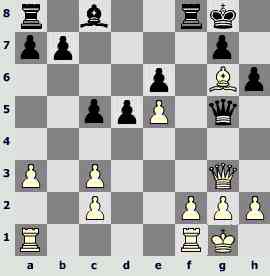
1...?
18. . . . ¦f8-f4!
It's important to prevent f2-f4. 18...Ј:g3?! 19.hgҐd7 20.f4 with subsequent g3-g4 and f4-f5 is weaker.
19.Јg3:g5 h6:g5
There is a danger of 20...¦c4. The ending is in favour of Black as there is a prospect to attack weak pawns of the opponent.
20.a4 Ґd7 21.a5 ¦af8! 22.f3 ¦h4! An excellent maneuver. Planned moves c5-c4, ¦h6 will put both the white bishop and the pawn е5 in a difficult position. For example, 23.g3 ¦h6 24.Ґd3 c4 25.Ґe2 ¦f5 26.f4 gf 27.gf ¦h4, or 23.Ґd3 c4 24.Ґe2 ¦f5.
23.g4?! c4! 24.Ґh5 ўh7 25.ўg2 g6.White resigned.
Vaganian – van der Wiel
Team championship of Europe, Plovdiv 1983
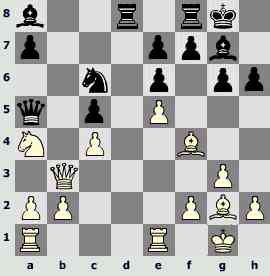
1.?
It's necessary to take urgent measures against 18...¤d4 and 18...g5.
18.Јb3-b5!
White reduces the force of ¤d4 by exchanging queens and attacks the pawn с5.
18...Ј:b5 19.cb ¤d4?!. Black hadmore active possibilities in case of 19...¤b4. 20.¦ac1 Ґ:g2. To 20...g5 21.Ґe3 Ґ:e5 both 22.¦:c5 and 22.Ґ:g5 are strong.
21.ў:g2 ¤:b5 22.¦:c5 ¦d5 23.¦e4! ¦fd8 24.Ґe3 ¦:c5?. It's an unsuccessfulexchange that gives White a free hand for operations at the queen side. Preferablewasat least 24...g5.
25.¤:c5 ¦d1? 26.¤a6! ¦d7 27.¦b4, and White won.
Timman – Diez del Corral
Olympiad, Lucern 1982
1.d4 ¤f6 2.c4 g6 3.¤c3 Ґg7 4.e4 d6 5.f3 0-0 6.Ґe3 ¤e8?! 7.Јd2 f5 8.ef gf 9.0-0-0 ¤a6 (to 9...¤d7 the response 10.g4 is unpleasant) 10.Ґd3 ¤c5 11.Ґc2 Јh4 (in the Timman's opinion, 11...a5 is better) 12.f4! ¤e4 13.¤:e4 fe 14.¤ge2 Ґg4 15.fe Ґ:e5 16.h3 Ґ:e2 17.Ј:e2 ¤g7
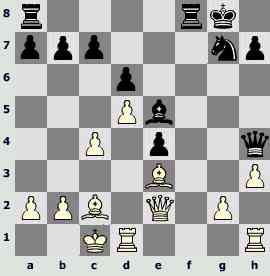
1.?
It's important to prevent the knight from entering the game through f5 or h5. 19.g4 isn't bad, but after 19...¦ae8 all the rest black pieces (except the knight) remain active, that hampers the further operations of White.
19.Јe2-g4! Јh4:g4
Perhaps, 19...Јg3 is a little better, to that 20.¦de1 ¦ae8 21.ўb1 came, and the position of Black is in unenviable.
20.h3:g4±
Having exchanged queens, White attacked the pawn е4, deprived the knight of the square f5 and opened the line "h". Considerable achievements.
20...Ґf4 21.ўd2! ¦f6?!(21...¦ae8 is more stubborn) 22.Ґ:e4 h6 23.¦df1 ¦af8 24.¦f3 Ґ:e3+ 25.ў:e3 ¦8f7 26.¦fh3 h5, and Black resigned.
Geller – Unzicker
Interzonal tournament, Saltshobaden 1952
1.d4 d5 2.c4 c6 3.¤f3 ¤f6 4.¤c3 dc 5.e4 b5 6.e5 ¤d5 7.a4 e6 8.ab ¤:c3 9.bccb 10.¤g5 Ґb7 11.Јh5 g6 12.Јg4 Ґe7 13.Ґe2 ¤d7 14.Ґf3! Јc7?
It's a hardly noticeable, but serious mistake. The theory of the Slavic gambit was only forming in those years, and the move in the game was recommended in the commentaries of Salo Flor. Later on it was ascertained that 14...Јc8! is correct. In such a way Black prevents an important move 15.¤e4, which will be followed by 15...0-0! 16.Ґh6 f5! 17.ef ¤:f6, and the pawn e6 is protected by the queen.
15.¤e4 ¤b6 16.Ґh6 (16.Ґg5) 16...¦g8?. Black repulses the threat 17.Ґg7 ¦g8 18.¤f6+ very unsuccessfully. Efim Geller recommends 16...¤d5, though the position after 17.Ґg5 0-0 18.Ґ:e7 Ј:e7 19.¤f6+ is obviously in favour of White.
17.Ґg5 Ґ:e4 18.Ґ:e4 ¤d5 19.Ґ:d5 ed 20.Ґ:e7 Ј:e7 21.0-0 ўf8 22.¦fb1 a6
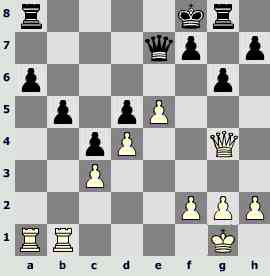
1.?
Black wants to consolidate by the move 23...ўg7. In case of 23.¦:b5? ab 24.¦:a8+ ўg7 the position of White is not better in view of the weakness of the pawn с3. 23.¦:a6? ¦:a6 24.Јc8+ ўg7 25.Ј:a6 ¦b8 also does not promise much.
23.Јg4-f3! Јe7-e6?!
23...ўg7 is more preferable. However in this situation White also gains a great advantage, for example: 24.Ј:d5 ¦gd8 25.Јe4 Јe6 26.f4 (in case of 26.¦:b5? ab 27.¦:a8 ¦:a8 28.Ј:a8 b4! 29.cb c3 the estimation changes to the opposite one) 26...f5 27.Јf3 ¦d5?! 28.¦:b5! (Geller) or 27.Јb7+!? Јd7 28.Јb6.
24.Јf3-f6!
While the king is stuck on the 8th rank, the position of Black is totally hopeless.
24...Јc8 (24...Ј:f6 25.efg5 26.¦:b5 ¦g6 27.¦:a6!) 25.f4 Јb7 26.¦a5 ўe8 27.¦ba1 b4 28.cbЈ:b4 29.¦:d5 Јb7 30.e6. Blackresigned.
A similar strategy was successfully used in the next game.
Philip – Korchnoi
Olympiad, Zigen 1970
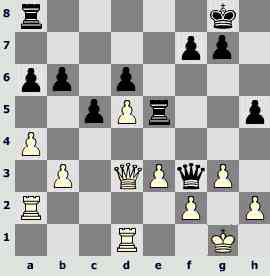
1...?
White wants to weaken the pressure of the opponent by proposing an exchange. For example: 27...h4?! 28.Јe2 Јf5 29.Јd3 Јh3 30.Јf1.
27. . . . g7-g5!
28.Јd3-e2 g5-g4µ
Now in case of exchange pawn f3 will considerably restrain the position of White, his king will be out of play for a long time.
29.Ј:f3?!(29.h4 is better) 29...gf 30.¦c2 ¦e4 31.¦c4 f5! 32.h3. To 32.ўf1!? Viktor Korchnoi suggests a variant 32...ўf7 33.ўe1 ўf6 34.ўd2 ўe5 35.ўc3 h4µ.
32...ўf7 33.ўh2 b5 (in case of 33...ўf6?! the response 34.g4 troubled Korchnoi, that's why he sped up events) 34.¦:e4 fe 35.¦a1 b4! 36.g4 h4! 37.g5 ¦c8 (the danger of 38...c4; if 38.¦c1, then 38...ўg6 39.¦c4 ўf5). White resigned.
Anand – Kamsky
11th game of the Candidate's match, Las Palmas 1995
1.e4 c5 2.¤f3 d6 3.d4 cd 4.¤:d4 ¤f6 5.¤c3 a6 6.Ґe3 e6 7.Ґe2 Ґe7 8.f4 ¤c6 9.Јd2 ¤:d4 10.Ј:d4 0-0 (10...b5?! is early in view of 11.a4!, as it was in the game Short – A.Sokolov, the Candidate's tournament, Monpele 1985) 11.0-0-0 Јa5?
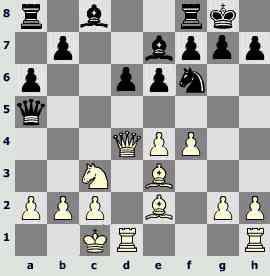
1.?
The last move of Black is a serious mistake. After a long castling there were no reasons to delay the strategically necessary advance 11...b5. In case of urgency it was possible to move the queen on с7 at first, but not on а5, as it was in the game.
12.Јd4-b6! Јa5:b6
13.Ґe3:b6±
Viswanathan Anand froze the queen side of the opponent. Development and space advantage together with the weakness of pawn d6 provide a stable advantage in the ending. No 13...¤d7 because of 14.Ґc7. To 13...Ґd7 14.e5 is strong, and if 13...e5, then 14.f5.
13...¤e8 14.e5!(the black king will be now out of play for a long time) 14...d5 15.f5! (15.Ґg4 g6! is less accurate with subsequent ¤g7) 15...Ґd7 16.Ґg4!Ґc8?(16...Ґb4 is more stubborn, to which 17.feҐ:e6 18.¤:d5! Ґ:g4 19.¦d4± would come) 17.¦hf1! a5 18.¤a4! f6 19.fe fe 20.¤c3! Ґg5+ (in case of 20...¦:f1 21.¦:f1 ¤f6 22.¦:f6!! decides with subsequent 23.¤:d5) 21.ўb1 ¤f6 22.¤:d5 ¤:g4 23.¦:f8+ (23.e7 ¦e8 24.¤c7 was also winning) 23...ў:f8 24.¤c7 ¦a6 25.Ґc5+! ўg8 26.¤:a6 Ґ:e6 27.¤c7 Ґf5 28.h3, and White made use of the extra exchange.
